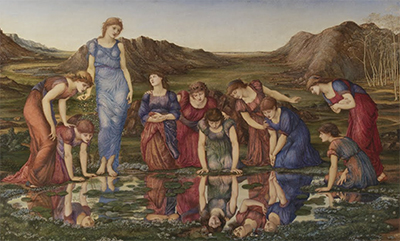The Mirror of Venus by Edward Burne-Jones is available in two versions. The larger version of the painting was completed in 1877. This work has been noted to be the perfect blend of Pre-Raphaelitism and the Italian Renaissance. The style used in the painting was Aestheticism, a style which has emerged at around 1860.
Aestheticism emphasised beauty more than socio-political themes, meaning the art forms did not need to have deeper messages. This painting shows Venus and her friends gazing upon their reflections in the water. Only one of the women fails to look at her image in the pool, and she simply looks at the woman on her side. The surrounding area is rocky and dry, and the water has formed a circular pool on the ground. The lunar landscape in this painting would later inspire other artists who were impressed by the style.
The bright colours employed in the paintings, as well as the delighted appearances of the women, show that Edward tried to incorporate Pre-Raphaelitism into the painting. The elements of Italian Renaissance art can be seen in the style used to depict the female figures in the picture. This style of art emphasised the graceful nature of such figures. It is evident that Edward adopted this style from the works of Sandro Botticelli, an Italian Renaissance artist whose works had inspired Edward for a long time.
The painting is not meant to tell a story and simply offers aesthetic appeal. You don't need to search for a deeper meaning to the painting since none was intended. You only need to appreciate the style of the painting and its beauty. When composing the image, Edward was inspired by the long epic poem Earthly Paradise by William Morris. When the first version of the painting was completed, it was sold to William Graham, a Scottish politician and art collector. The artist completed the second and larger version of the painting in 1875, and this one was sold to Fredrick Richards Layland. The second painting is now in the Gulbenkian Foundation in Lisbon.




